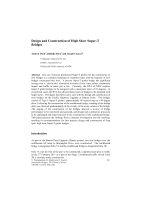Bridges

- Publication no: ABC-DES009-11
- Published: 31 October 2011
- PDF (free) Download
The use of precast prestressed Super-T girders for the construction of new bridges is a common technique in Australia today with the majority of new bridges constructed this way. A precast Super-T girder bridge has significant savings over a ‘cast-in-situ’ alternative in terms of cost, time, safety, community impact and traffic to name just a few. Currently, the RTA of NSW requires Super-T girder bridges to be designed with a maximum skew of 35 degrees. In exceptional cases, the RTA has allowed these types of bridges to be designed with larger skews. This paper describes such a case with the design and construction of twin bridges on the Pacific Highway Upgrade at Banora Point. The bridges consist of Type 5 Super-T girders, approximately 40 metres long on a 40 degree skew. Following the construction of the northbound bridge, cracking of the bridge deck was observed predominantly in the vicinity of the acute corners of the bridge. The staging of the construction of the bridges allowed a review of bridge performance to be monitored and assessed, and design and construction processes to be challenged and improved prior to the construction of the southbound bridge. This paper presents the findings from a detailed investigation into the cracking, resulting in recommendations for best practice design and construction of long span, high skew Super-T girder bridges.
